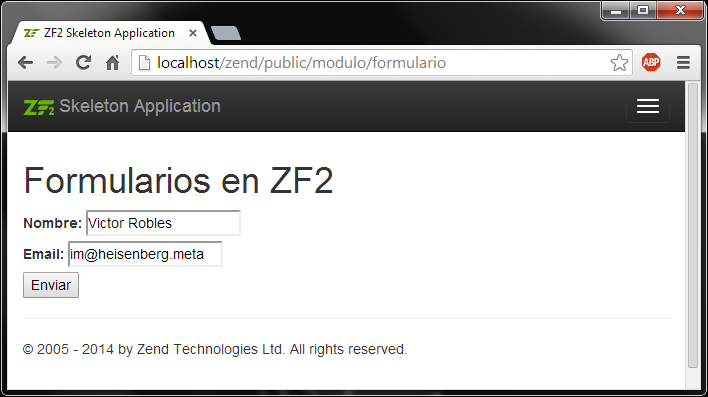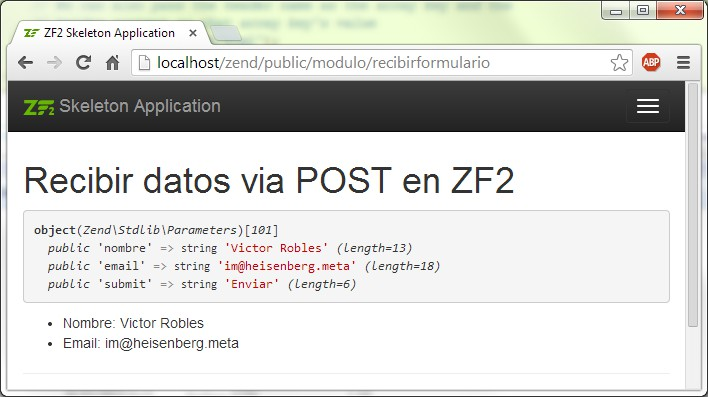Para crear formularios en Zend Framework 2 tenemos que definir clases que extiendan al componente Form(evidentemente también podemos ponerlos en las vistas directamente en HTML). Dentro de src hay que crear un directorio llamado Form y dentro irán los ficheros de cada formulario.
El formulario module/Modulo/src/Modulo/Form/FormularioPruebas.php
<?php
namespace Modulo\Form;
use Zend\Captcha\AdapterInterface as CaptchaAdapter;
use Zend\Form\Element;
use Zend\Form\Form;
use Zend\Captcha;
use Zend\Form\Factory;
class FormularioPruebas extends Form{
//Le ponemos un nombre al formulario
public function __construct($name = null){
parent::__construct($name);
//Podemos añadir campos al formulario de esta forma
$this->add(array(
'name' => 'nombre',
'options' => array(
'label' => 'Nombre: ',
),
'attributes' => array(
'type' => 'text',
'class' => 'input'
),
));
//También podemos utilizar factory
$factory = new Factory();
//Creando elementos de una manera similar a la anterior
$email = $factory->createElement(array(
'type' => 'Zend\Form\Element\Email',
'name' => 'email',
'options' => array(
'label' => 'Email: ',
),
'attributes' => array(
'class' => 'input_email',
'id' => 'input_email'
),
));
$this->add($email);
//Creamos el boton de submit
$this->add(array(
'name' => 'submit',
'attributes' => array(
'type' => 'submit',
'value' => 'Enviar',
'title' => 'Enviar'
),
));
}
}
?>
El controlador
<?php
namespace Modulo\Controller;
use Zend\Mvc\Controller\AbstractActionController;
use Zend\View\Model\ViewModel;
//Incluir modelos
use Modulo\Model\Entity\PruebasModel;
//Incluir formularios
use Modulo\Form\FormularioPruebas;
class PruebasController extends AbstractActionController{
public function indexAction(){
return new ViewModel();
}
public function formularioAction(){
//Creamos el objeto del formulario
$form=new FormularioPruebas("form");
//Le pasamos a la vista el formulario y la url base
return new ViewModel(array(
"titulo"=>"Formularios en ZF2",
"form"=>$form,
'url'=>$this->getRequest()->getBaseUrl())
);
}
public function recibirFormularioAction(){
/*Este metodo se encarga de recojer los datos de el formulario
* si a sido enviado y si redirecciona al formulario
*/
if($this->request->getPost("submit")){
$datos=$this->request->getPost();
return new ViewModel(array("titulo"=>"Recibir datos via POST en ZF2","datos"=>$datos));
}else{
return $this->redirect()->toUrl(
$this->getRequest()->getBaseUrl().'/modulo/formulario'
);
}
}
}
La vista, pintar el formulario
<h1><?php echo $this->titulo?></h1>
<?php
//Preparamos el formulario
$form = $this->form;
$form->prepare();
//Definimos el atributo action y method
$form->setAttributes(array(
'action' => $this->url.'/modulo/recibirformulario',
'method' => 'post'
));
//Utilizamos el plugin para mostrar los label
$formLabel = $this->plugin('formLabel');
echo $this->form()->openTag($form);
?>
<div class="form_element">
<?php
//Imprimimos el campo nombre
$nombre = $form->get('nombre');
echo $formLabel->openTag().$nombre->getOption('label')." ";
echo $this->formInput($nombre);
echo $formLabel->closeTag();
?>
</div>
<div class="form_element">
<?php
//Imprimimos el campo email
$email = $form->get('email');
echo $formLabel->openTag().$email->getOption('label')." ";
echo $this->formInput($email);
echo $formLabel->closeTag();
?>
</div>
<?php
//Imprimimos el boton de enviar
echo $this->formElement($form->get('submit'));
//Cerramos el formulario
echo $this->form()->closeTag();
?>
Podemos imprimir el formulario completo con
$form = $this->form;
$form->setAttributes(array(
'action' => $this->url.'/modulo/recibirformulario',
'method' => 'post'
));
$form->prepare();
echo $this->form()->openTag($form);
echo $this->formCollection($form);
echo $this->form()->closeTag();
recibirformulario.phtml
<h1><?php echo $this->titulo?></h1>
<?php var_dump($datos); ?>
<ul>
<li>Nombre: <?=$datos->nombre?></li>
<li>Email: <?=$datos->email?></li>
</ul>
Podemos conseguir mucha más información sobre formularios en la documentación oficial de Zend Framework 2:
Zend Form Quick Start
Como crear los diferentes elementos de los formularios



















